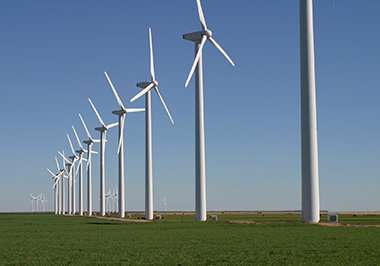Credit: Wikimedia Commons
In 2012, a study led by UAlbany atmospheric scientist Liming Zhou analyzed nine years of NASA satellite data to present the first observational evidence of turbine induced nighttime warming effects in a west-central Texas region covered with wind farms.
Zhou is now simulating those findings to further understand how wind farms may be interacting with local climate.
In his latest study, Zhou, along with a team of atmospheric scientists, simulated the land surface temperature response of 2,358 wind turbines that are located in the same west-central Texas region as his previous studies. The simulations were conducted during the month of July for seven years from 2003 to 2004 and 2010 to 2014 using the Weather Research and Forecasting (WRF) model, a next generation mesoscale numerical weather prediction system.
Over time, the simulated wind turbines reproduced the satellite observed local warming effect within about one tenth of a degree (.20 to .26 °C on average). However, they also produced a downwind cooling effect (-0.2 °C on average) in the vicinity behind the wind farm region at night. Something that was not found by previous studies.
Results were published last month in the American Meteorological Society's Monthly Weather Review.
"This is the first numerical modeling study to simulate the impacts of real-world wind farms on land surface temperature driven by realistic initial and boundary conditions," said Zhou, an associate professor in UAlbany's Department of Atmospheric and Environmental Sciences (DAES).
"The simulated cooling effect has not been confirmed by our satellite observations or any previous field campaigns. If it turns out to be true, it would suggest another potential environmental side effect for large wind farms that requires further scientific investigation," added Geng Xia, a graduate student at UAlbany and lead author of the study.
Zhou and his team have hypothesized that the warming effect over the wind farm region is most likely the result of a downward heat transport. The turbine acts like a fan, pulling down warmer air from the higher altitudes to the surface at night. However, the downwind cooling effect could tell a different story. Due to turbine influence, the near-surface stability over the region behind the wind farm increases, providing a favorable condition for heat to the leave the ground.
Those involved with the study caution that additional observations are needed before making definitive conclusions, especially for the downwind cooling effect.
"Caution should be taken when interpreting the simulated nighttime cooling signal because it has not been confirmed by any previous observations," said Justin Minder, a co-author of the study and DAES assistant professor.
"More research is needed to fully understand these findings. If the downwind cooling signal cannot be identified in observations, it could suggest a limitation in how the model is representing the mixing of the atmosphere in the vicinity of the turbines. Additional comparisons of simulations with observations should improve the treatment of wind turbine effects in future simulations."
Wind power has experienced a remarkable growth in recent years and is widely acknowledged as a key resource to reducing the world's dependence on fossil fuels. It is affordable, creates no emissions and is considered a viable renewable energy option. There are currently more than 52,000 wind turbines in 41 states, producing enough electricity for 25 million American homes.
Zhou and his team are dedicated to studying the interaction between wind farms and climate to ensure sustainable growth for the industry.
"Wind power is playing a crucial role in mitigating climate change by accelerating meaningful reductions in our use of fossil fuels," said Jeff Freedman, an atmospheric scientist at UAlbany's Atmospheric Sciences Research Center (ASRC). "We need to understand the physical processes and mechanisms driving the interactions between these large wind turbines and the local weather and climate as wind energy continues its rapid growth as a viable and beneficial alternative to non-renewable polluting energy sources."
More information: Geng Xia et al. Simulating Impacts of Real-World Wind Farms on Land Surface Temperature Using the WRF Model: Validation with Observations, Monthly Weather Review (2017). DOI: 10.1175/MWR-D-16-0401.1
Journal information: Monthly Weather Review
Provided by University at Albany
























